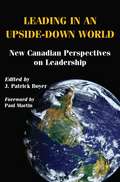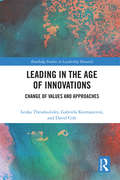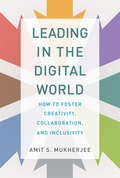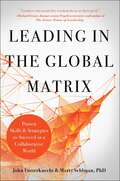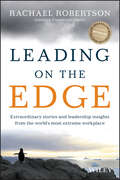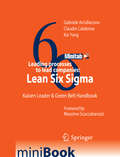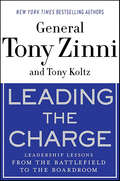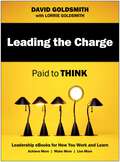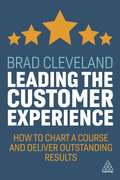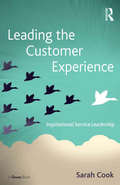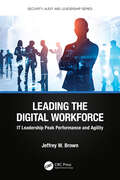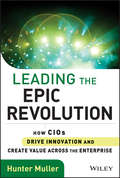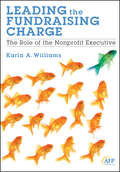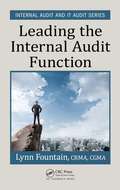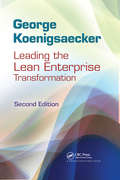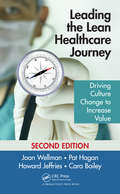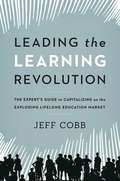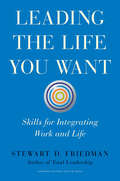- Table View
- List View
Leading in an Upside-Down World: New Canadian Perspectives on Leadership
by J. Patrick Boyer The Right Honourable Paul MartinThe world as we know it has been turned upside down by recent events but it’s still a place where leadership is needed more than ever. Fifteen Canadians with highly diverse perspectives and richly different experience explore this timely question in Leading in an Upside-Down World. Chapter by chapter, stories of Canada unfold and future prospects for leadership grow clearer as these eminent Canadians explain how to "recognize leadership" in an age where old institutions and behaviours are being left behind. They also identify leadership attributes that endure. Leading in an Upside-Down World gives voice to both scholars and practitioners of Canadian-style leadership.
Leading in the Age of Innovations: Change of Values and Approaches (Routledge Studies in Leadership Research)
by David Cole Lenka Theodoulides Gabriela KormancováLeading in the Age of Innovations centres on the need for a more complex process-relational oriented approach to leadership. The complexity of leadership has grown significantly during the 21st century where the need to adapt to the escalating changes in our society and workplace forms one of the most important prerequisites to succeed. Leading in the Age of Innovations represents the outcomes of the lengthy scientific work that was undertaken for the past 10 years and it is still an ongoing process. This book introduces a new concept of leadership based on the process and relational dimensions which resulted in the development of the Reflective Leadership concept. The new model of leadership provides a unique concept on how to bring together various disciplines and explains the overlapping relations between them. Moreover, the proposed view on leadership reflects the current evolution around the globe highlighting the importance of change and innovation. In organizations, too much focus is on the end product and the technical details of how a product is made and distributed. Less attention is focused on how people interact, and how the human capacity is effectively supported by leaders who, on the other hand, are expected to support a culture of innovation. This behavioural interaction is governed by a set of predictable values and norms. These relationships need to be understood for an organization to prosper and is thus far more important to the leadership process. Leading in the Age of Innovations seeks to establish this understanding and will be key reading to researchers, scholars and practitioners alike in the field of leadership, organizational studies and related disciplines.
Leading in the Digital World: How to Foster Creativity, Collaboration, and Inclusivity (Management on the Cutting Edge)
by Amit S. MukherjeeThe definitive book on leadership in the digital era: why digital technologies call for leadership that emphasizes creativity, collaboration, and inclusivity.Certain ideas about business leadership are held to be timeless, and certain characteristics of leaders—often including a square jaw, a deep voice, and extroversion—are said to be universal. In Leading in the Digital World, Amit Mukherjee argues that since digital technologies are changing everything else, how could they not change leadership ideologies and styles? As more people worldwide participate equally in business, those assumptions of a leader's ideal profile have become irrelevant. Offering a radical rethinking of leadership, Mukherjee shows why digital technologies call for a new kind of leader—one who emphasizes creativity, collaboration, and inclusivity.Drawing on a global survey of 700 mid-tier to senior executives and interviews with C-level executives from around the world, Mukherjee explains how digital technologies are already reshaping organizations and work and what this means for leaders. For example, globally dispersed businesses can't reserve key leadership roles for people from exclusive groups; leadership must become inclusive, or fail. Leaders must learn to collaborate in a multipolar world of networked organizations, working with co-located and non-co-located colleagues. Leaders must lead for creativity rather than productivity. Focusing on practice, Mukherjee outlines goals and strategies, warns against unthinking assumptions, and explains how leaders can identify the mindsets, behaviors, and actions they need to pursue. With Leading in the Digital World, Mukherjee offers the definitive book on leadership for the digital era.
Leading in the Global Matrix: Proven Skills and Strategies to Succeed in a Collaborative World
by Marty Seldman John FutterknechtEnter the matrix . . . and discover a whole new reality for your organization. In today's global business world, many organizations are shifting away from decentralized, vertical structures—with silo functions such as finance, HR, or operations—to a "matrix" model of cross-functional teams that work across a number of business units. When executed successfully, a matrix structure helps companies thrive in the modern market by better leveraging internal resources, eliminating duplication, spurring innovation, and driving enterprise-wide strategy. However, integrating matrix structures is often a challenge for organizations. John Futterknecht and Marty Seldman, PhD, have worked with some of the world's largest companies—including PepsiCo, Disney, McDonald's, and Microsoft—to investigate and conquer the challenges that arise with these highly integrated organizational structures. Through coaching hundreds of leaders and training thousands for on success in a matrix environment, they have witnessed first-hand which skills and strategies are most critical for matrix success . . . and now they're sharing these breakthrough, field-tested tips with you. Leading in the Global Matrix offers a real-world perspective of working in a matrix while using examples from the authors' actual coaching of business leaders. This book tackles the critical, "unspoken" dimensions that are often underestimated and unaddressed in the global business world, helping readers learn: specific skills and insights that can help them be successful in the trenches how to deal with day-to-day realities—which include complexity, pressure, and demand to deliver results with speed what to do, why it's important, and how to accomplish each task With concrete action plans, readers can implement what they learn in the book into their everyday work lives. Leading in the Global Matrix encapsulates field-tested advice to help individual professionals and their teams unlock their full potential, allowing the matrix to finally deliver on its promise.
Leading on the Edge
by Rachael RobertsonLessons on authentic leadership from the 58th annual Antarctic expeditionIn Leading on the Edge, successful business speaker and consultant Rachael Robertson shares the lessons she learned as leader of a year-long expedition to the wilds of Antarctica. Leading eighteen strangers around the clock for a full year--through months of darkness and with no escape from the frigid cold, howling winds, and each other--Robertson learned powerful lessons about what real, authentic leadership is. Here, she offers a deeply honest and humorous account of what it takes to survive and lead in the harshest environment on Earth. What emerges from her graphic account is a series of powerful and practical lessons for business leaders and managers everywhere.Features practical leadership lessons that are particularly helpful for any leader who must get the best out of the team they've gotFeatures solutions to many challenges common to all workplacesIncludes real excerpts from Robertson's personal journals through twelve months of leading in the most challenging environment in the worldWritten by a popular speaker and business leader who has appeared at more than 350 national and international conferences and events for a wide range of industriesLeading on the Edge explains what it's like to take charge when you've no place to hide and how truly harsh environments can serve as a leadership laboratory that results in truly effective, authentic leadership.
Leading on the Edge: Extraordinary Stories and Leadership Insights from The World's Most Extreme Workplace
by Rachael RobertsonLessons on authentic leadership from the 58th annual Antarctic expedition In Leading on the Edge, successful business speaker and consultant Rachael Robertson shares the lessons she learned as leader of a year-long expedition to the wilds of Antarctica. Leading eighteen strangers around the clock for a full year—through months of darkness and with no escape from the frigid cold, howling winds, and each other—Robertson learned powerful lessons about what real, authentic leadership is. Here, she offers a deeply honest and humorous account of what it takes to survive and lead in the harshest environment on Earth. What emerges from her graphic account is a series of powerful and practical lessons for business leaders and managers everywhere. Features practical leadership lessons that are particularly helpful for any leader who must get the best out of the team they've got Features solutions to many challenges common to all workplaces Includes real excerpts from Robertson's personal journals through twelve months of leading in the most challenging environment in the world Written by a popular speaker and business leader who has appeared at more than 350 national and international conferences and events for a wide range of industries Leading on the Edge explains what it's like to take charge when you've no place to hide and how truly harsh environments can serve as a leadership laboratory that results in truly effective, authentic leadership.
Leading processes to lead companies: Kaizen Leader & Green Belt Handbook
by Claudio Calabrese Gabriele Arcidiacono Kai YangThis Minibook is a brief guide for Green Belt during a Lean Six Sigma project management or for Kaizen Leader during a process improvement activity. Through both its theoretical concepts and practical examples it is a pocket book for a quick consultancy. Authors idea comes from companies needs in order to analyze information useful to know in depth different kind of processes. The set of Six Sigma tools are explained through Minitab 16, the last release of the most widely used statistical software.
Leading the Charge: Leadership Lessons from the Battlefield to the Boardroom
by Tony Koltz Tony Zinni"What's happened to our leaders and to our leadership?"Based on General Zinni's leadership experiences from the battlefield to the boardroom, Leading the Charge shows a new way through the significant leadership challenges of the 21st century.The times are changing at an ever-increasing velocity. Old systems, organizations, and ways of operating no longer work in our dynamic, complex and increasingly unstable new environment. Out of this chaos and confusion, a new and different leader must emerge. Old systems and methods will no longer work. Leading the Charge is a visionary leadership book that examines the trends that have reshaped our world and the ways in which visionary leaders and organizations can effectively respond. Tomorrow's successful leaders--in all fields, including the military, academia, politics, and business--must know how to create, operate, and thrive in very fluid, flattened, and integrated structures that are remarkably different from the traditional organizations we are used to seeing. They will have to manage rapidly changing technology and flows of information, and create faster and more far-reaching spans of control. Leading the Charge shows the way, and is an incisive and compelling guide to the new world of leadership, one that will prove indispensable for years to come.Organized around "Leading a New World," a revolutionary leadership course General Zinni developed and taught at the Terry Sanford Institute of Public Policy at Duke University, Leading the Charge makes a convincing case that leaders must . . . - change with the times to be relevant.- be ready for crisis mode at any given time.- have a moral compass and the ability to steer the company in the right direction.- be forward thinking, not reactive, to provide innovation and creativity.- develop great leaders.
Leading the Charge: Paid to Think
by David GoldsmithWhat lessons can be learned from historical leaders' successes? How has management actually hindered the modern-day leader? Do you know how your personal aspirations and concerns are sabotaging your professional successes? Leading the Charge contains eye-opening revelations that will put you in control, marry private and public aspects of your personality, and deliver a higher quality of life than you could ever imagine.
Leading the Customer Experience: How to Chart a Course and Deliver Outstanding Results
by Brad ClevelandMany organizations and leaders struggle to respond effectively to fast-evolving customer expectations driven by innovations in products, services and technologies such as AI and mobile. Failing to build the necessary strategy, culture and processes, they suffer from high costs, dissatisfied customers and brand damage. The mandate to get customer experience right is real and urgent. Leading the Customer Experience is a guide to shaping experiences that win loyalty and deliver outstanding business results. It provides a bold, step-by-step approach that will get you and your team pointed in the right direction. And equipped to make sound decisions along the way. Leading the Customer Experience is easy to understand and imminently practical. It is based on the author's extensive experience both as a founding partner of one of the world's most influential customer management organizations, and his work with B2B and B2C organizations in the private and public sectors.The author's down-to-earth explanations cut through jargon and clutter, while stories and examples bring important principles to life. Leading the Customer Experience is relatable to anyone leading, managing or aspiring to better understand customer experience.
Leading the Customer Experience: Inspirational Service Leadership
by Sarah CookLeading the Customer Experience explores the relationship between leadership behaviour and exceptional service. Most organisation’s strategic aims and goals centre on the delivery of excellent service. Loyal customers not only keep buying from a company but also recommend the business to others. It is clear that managers and leaders throughout an organisation have a key influence on the experience that customers receive. How leaders behave has a direct impact on their team member’s motivation to go the extra mile to deliver excellent service for the customer. Sarah Cook’s vision for Leading the Customer Experience is to provide practical advice, tools and techniques for managers in how to effectively lead and motivate their team to deliver the best possible customer service. This book encapsulates her research on the behaviours of leaders who successfully create an environment where employees deliver exceptional service and she brings a pragmatic and business focused approach to the topic. Each chapter contains a variety of case study examples from businesses in UK and Europe, Asia Pacific, US and BRIC countries. These include service organisations in the financial sector, manufacturing, hospitality, transport, healthcare, public and third sectors.
Leading the Digital Workforce: IT Leadership Peak Performance and Agility (Security, Audit and Leadership Series)
by Jeffrey W. BrownFuture IT leaders won't be technology leaders, they'll be business leaders who understand technology. Leading the Digital Workforce takes a fresh look at technology leadership, exploring how to lead and manage in today’s digital workplace where the pace of change is exponential. This book walks you through building personal resiliency and avoiding stress and burnout to creating a strategy, building a high-performance team, and examining how technology will change the workforce of the future. Technology leadership requires a unique set of skills, which is why traditional leadership approaches don't always work. This book provides actionable advice on how to create a culture of innovation while driving successful change initiatives. Leading the Digital Workforce provides strategies for empowering people, optimizing processes, and inspiring innovation. This book offers insights into managing change, leveraging technology, and building strong relationships within your organization, including how to understand and work with company culture. Finally, it shares strategies for using technology and innovation to create a competitive edge to unlock new opportunities. Leading the Digital Workforce is essential reading for IT leaders who want to develop their skills, stay ahead of the digital curve, and lead their organizations into the future. No matter if you’re a new IT leader, an aspiring one, or a seasoned leader who’s been at it for years, there’s something in this book that will help you level up your game.
Leading the Enterprise: Improvisation and Adaptability-What Western Business Leaders Can Learn from the India Way
by Michael Useem Peter Cappelli Harbir Singh Jitendra V. SinghOne of the defining qualities of the India Way of doing business is its distinctive style of leadership. India's business leaders think broadly and act pragmatically. They set grand agendas and then rely on trial and error (and personal resilience) to see what works and what doesn't. In this chapter, authors Peter Cappelli, Harbir Singh, Jitendra Singh, and Michael Useem describe one of four principal practices of the India Way-improvisation and adaptability-and show, using richly detailed examples such as Hindustan Unilever (India's largest consumer products company) and banking juggernaut Industrial Credit and Investment Corporation of India, how Indian business leaders create sustainable profitable growth from the ground up. As Western companies struggle to regain their footing in the wake of the 2008-2009 economic collapse, the phenomenal successes Indian executives have achieved-in an ever-changing business landscape-offer inspiration as well as instruction. This chapter was originally published as Chapter 4 of The India Way: How India's Top Business Leaders Are Revolutionizing Management.
Leading the Epic Revolution
by Hunter MullerA must-read leadership guide for CIOs and executives whose careers depend on creating value and growth through continuous innovationInnovation is the hot topic. Everyone's talking about it, but there seems to be a lot of misperceptions about getting it done. Innovating for Growth and Value is aimed at CIOs and other technology leaders in the modern enterprise. This insider's guide to innovation presents repeatable processes, detailed methodologies, and robust frameworks for innovation and continuous transformation in today's fast-paced business environments. It provides actionable programs for developing and successfully executing profitable and repeatable innovation strategies.Focuses on specific critical areas where innovation is imperativeFeatures real-world stories and revealing anecdotesPresents interviews from international companies such as Netflix, IBM, Cisco, Boeing, Facebook, Intel, Microsoft, McKesson, Flextronics, and moreWithout innovation, your company cannot compete and cannot survive. So the real question isn't whether to innovate or not. The real question is how to innovate and make innovation strategies work in the modern enterprise. Thoughtfully written and carefully researched, Innovating for Growth and Value grasps the central truth about innovation with a wealth of information made truly valuable for IT leaders and CIOs.
Leading the Family Business Through Succession: How Different Generations Create Value Together
by Professor Dr Michael Hilb Professor Harry KorineLeading the Family Business Through Succession examines leadership and succession in family business, showing how current and next generation members can develop the business side by side.It challenges the traditional, hierarchical model of leadership and succession in family business, showing that this approach is no longer aligned to modern organizational needs. Instead, this book examines how current and next generations can bridge the gap and co-evolve as peers for a significant stretch of time. It outlines leadership practices families can employ to navigate the transition towards new ways of working together and how generations can collaborate to address the myriad challenges and opportunities affecting businesses today, balancing legacy and transformation. This book is informed by methodologies tried-and-tested in years of MBA and executive-level teaching at business schools such as INSEAD, St Gallen and London Business School. Taking a global approach and drawing on cutting edge insights and research, it provides case studies and examples featuring family businesses from around the world, such as Europe, the Americas, the Far East and the Middle East, highlighting how different family businesses can learn from each other. It is ideal for MBA and executive level courses on family business and will also be of interest to family business leaders, advisors and managers.
Leading the Fundraising Charge: The Role of the Nonprofit Executive
by Karla A. WilliamsPractical guidance to deal with the challenges executives face when leading a philanthropically supported nonprofit organization In today's donor-focused environment, the executive director has a greater responsibility to play an active, informed, and influential role in creating an environment that is conducive to optimal philanthropy. Leading the Fundraising Charge addresses the challenges and issues that executives face when leading a nonprofit organization that is dependent on philanthropic support. . Offers nonprofit directors and executives the tools they need to help their organizations survive and thrive in any economic scenario Provides a perspective that is unique to the nonprofit executive's position Helps every executive director to evaluate and prioritize the best fund development strategies At no other time in the history of organized philanthropy has fundraising been more critical, complex, and challenging. Thorough and focused, Leading the Fundraising Charge equips you with the guidance you need to lead your nonprofit effectively.
Leading the Future of Technology: The Vital Role of Accessible Technologies (Elements in Leadership)
by Rebecca LaForgiaThere is presently a view that accessible technologies offer an inclusive and humanistic expression of technology. They do. But that is not all. Accessible technologies offer more than this: they contain within them lessons on transformational leadership. Through examining six case studies the reader will begin to interpret these accessible technologies as expressions of leadership. The risk inherent in the current view is that to view accessible technologies only as examples of humanism, or the good, is to risk underselling them. In fact, accessible technologies (which are being created across international society) represent a powerful leadership approach to technology itself. Through their leadership, these accessible technologies demand and create new and original thinking by society. The reader will benefit from this Element by learning to identify transformational leadership within accessible technological creations and consequently gaining a capacity to apply this leadership to the very purposes of technology itself.
Leading the Internal Audit Function (ISSN #1)
by Lynn FountainIn this book, the author presents lessons learned from her extensive experience as a CAE to help internal auditors understand the challenges, issues, and potential alternative solutions when executing the role. The book explains how to clarify management expectations for the internal audit and balance those expectations with the IIA Standards. It examines the concept of risk-based auditing and explains how to determine whether management and the internal audit team have the same objectives. It also looks at the internal auditor's role in corporate governance and fraud processes.
Leading the Josie Esquivel Franchise (A)
by Boris Groysberg Laura Morgan RobertsReviews Josie Esquivel's career history, detailing how, through her personal attributes, skills, experiences, and organizational practices she has developed into a star analyst. Should Esquivel accept an offer to leave Lehman Brothers for Morgan Stanley? To make this decision, Esquivel needs to reflect on what made her successful and to consider seriously what it would take to move her "franchise" to another company without compromising her performance as a star.
Leading the Lean Enterprise Transformation
by George Koenigsaecker Hamdy TahaUpdated with new information, illustrations, and leadership tools, Leading the Lean Enterprise Transformation, Second Edition describes how the metrics used by Toyota drive every line item in a financial statement in the right direction. Rather than focus on Lean tools and principles, the new edition of this bestselling reference focuses on what ma
Leading the Lean Healthcare Journey: Driving Culture Change to Increase Value, Second Edition
by Joan Wellman Pat Hagan Howard Jeffries Cara BaileyThis book reveals and describes the leadership and culture change required to remove waste from healthcare processes and eliminate the root cause of soaring costs, poor quality and safety, and limited access. The book's delivery strategy revolves around personal and organizational stories and case studies told by physician and administrative leaders, all students of the Toyota Production System. This revised edition uniquely blends updated case studies with practical theory to describe how the healthcare value proposition can be changed by reducing waste, variation and complexity in healthcare. New to the book are chapters on clinical standard work and integration of lean and safety.
Leading the Learning Revolution: The Expert's Guide to Capitalizing on the Exploding Lifelong Education Market
by Jeff CobbLifelong learning has become a multibillion-dollar business, with more than 60 million adults currently engaged in webinars, webcasts, in-house training, continuing education classes, and more. But it is also an industry in flux, as newcomers topple old-guard organizations that cant keep pace with the need for instant access to materials and flexible delivery methods, as well as demands for community and connection. Leading the Learning Revolution is the first book to explain how to tap into this lucrative market, which rewards the most forward-thinking training firms, professional associations, continuing education programs, entrepreneurial speakers and consultants, and others. Filled with insights from the authors vast experience, field-tested strategies, interviews, and anecdotes, the book explains how to: Use technology to create high-impact learning opportunities Develop content that is faster and better than the competitions Convert prospects to customers by building connection Focus on the bottom-line results of lifelong learning Successful people and organizations never stop learning, and the people and organizations that lead that learning will never stop growing!
Leading the Life You Want
by Stewart D. Friedman"For nearly thirty years, my life's work has been to help people like you find ways to bring the often warring aspects of life into greater harmony." - Stew Friedman, from Leading the Life You WantYou're busy trying to lead a "full" life. But does it really feel full-or are you stretched too thin? Enter Stew Friedman, Wharton professor, adviser to leaders across the globe, and passionate advocate of replacing the misguided metaphor of "work/life balance" with something more realistic and sustainable. If you're seeking "balance" you'll never achieve it, argues Friedman. The idea that "work" competes with "life" ignores the more nuanced reality of our humanity-the interaction of four domains: work, home, community, and the private self. The goal is to create harmony among them instead of thinking only in terms of trade-offs. It can be done.Building on his national bestseller, Total Leadership, and on decades of research, teaching, and practice as both consultant and senior executive, Friedman identifies the critical skills for integrating work and the rest of life. He illustrates them through compelling original stories of these remarkable people: former Bain & Company CEO and Bridgespan co-founder Tom Tierney Facebook COO and bestselling author Sheryl Sandberg nonprofit leader and US Navy SEAL Eric Greitens US First Lady Michelle Obama soccer champion-turned-broadcaster Julie Foudy renowned artist Bruce SpringsteenEach of these admirable (though surely imperfect) people exemplifies a set of skills-for being real, being whole, and being innovative-that produce a sense of purpose, coherence, and optimism.Based on interviews and research, their stories paint a vivid picture of how six very different leaders use these skills to act with authenticity, integrity, and creativity-and they prove that significant public success is accomplished not at the expense of the rest of life, but as the result of meaningful engagement in all its parts. With dozens of practical exercises for strengthening these skills, curated from the latest research in organizational psychology and related fields, this book will inspire you, inform you, and instruct you on how to take realistic steps now toward leading the life you truly want.
Leading the Life You Want
by Stewart D. Friedman"For nearly thirty years, my life's work has been to help people like you find ways to bring the often warring aspects of life into greater harmony." - Stew Friedman, from Leading the Life You WantYou're busy trying to lead a "full" life. But does it really feel full-or are you stretched too thin? Enter Stew Friedman, Wharton professor, adviser to leaders across the globe, and passionate advocate of replacing the misguided metaphor of "work/life balance" with something more realistic and sustainable. If you're seeking "balance" you'll never achieve it, argues Friedman. The idea that "work" competes with "life" ignores the more nuanced reality of our humanity-the interaction of four domains: work, home, community, and the private self. The goal is to create harmony among them instead of thinking only in terms of trade-offs. It can be done.Building on his national bestseller, Total Leadership, and on decades of research, teaching, and practice as both consultant and senior executive, Friedman identifies the critical skills for integrating work and the rest of life. He illustrates them through compelling original stories of these remarkable people: former Bain & Company CEO and Bridgespan co-founder Tom Tierney Facebook COO and bestselling author Sheryl Sandberg nonprofit leader and US Navy SEAL Eric Greitens US First Lady Michelle Obama soccer champion-turned-broadcaster Julie Foudy renowned artist Bruce SpringsteenEach of these admirable (though surely imperfect) people exemplifies a set of skills-for being real, being whole, and being innovative-that produce a sense of purpose, coherence, and optimism.Based on interviews and research, their stories paint a vivid picture of how six very different leaders use these skills to act with authenticity, integrity, and creativity-and they prove that significant public success is accomplished not at the expense of the rest of life, but as the result of meaningful engagement in all its parts. With dozens of practical exercises for strengthening these skills, curated from the latest research in organizational psychology and related fields, this book will inspire you, inform you, and instruct you on how to take realistic steps now toward leading the life you truly want.
Leading the Life You Want: Skills for Integrating Work and Life
by Stewart D. Friedman"For nearly thirty years, my life's work has been to help people like you find ways to bring the often warring aspects of life into greater harmony. " - Stew Friedman, from Leading the Life You Want You're busy trying to lead a "full" life. But does it really feel full-or are you stretched too thin? Enter Stew Friedman, Wharton professor, adviser to leaders across the globe, and passionate advocate of replacing the misguided metaphor of "work/life balance" with something more realistic and sustainable. If you're seeking "balance" you'll never achieve it, argues Friedman. The idea that "work" competes with "life" ignores the more nuanced reality of our humanity-the interaction of four domains: work, home, community, and the private self. The goal is to create harmony among them instead of thinking only in terms of trade-offs. It can be done. Building on his national bestseller, Total Leadership, and on decades of research, teaching, and practice as both consultant and senior executive, Friedman identifies the critical skills for integrating work and the rest of life. He illustrates them through compelling original stories of these remarkable people: - former Bain & Company CEO and Bridgespan co-founder Tom Tierney - Facebook COO and bestselling author Sheryl Sandberg - nonprofit leader and US Navy SEAL Eric Greitens - US First Lady Michelle Obama - soccer champion-turned-broadcaster Julie Foudy - renowned artist Bruce Springsteen Each of these admirable (though surely imperfect) people exemplifies a set of skills-for being real, being whole, and being innovative-that produce a sense of purpose, coherence, and optimism. Based on interviews and research, their stories paint a vivid picture of how six very different leaders use these skills to act with authenticity, integrity, and creativity-and they prove that significant public success is accomplished not at the expense of the rest of life, but as the result of meaningful engagement in all its parts. With dozens of practical exercises for strengthening these skills, curated from the latest research in organizational psychology and related fields, this book will inspire you, inform you, and instruct you on how to take realistic steps now toward leading the life you truly want.
